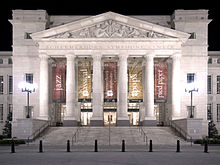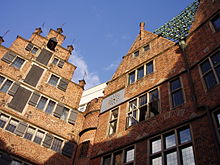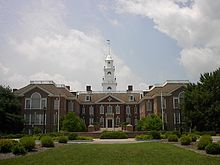New Classical architecture is a contemporary movement in architecture, that continues the practice of classical and traditional architecture. The design and construction of buildings in these traditions is continuous throughout the twentieth and twenty-first centuries, even as modernist and other post-classical theories of architecture have been more dominant.
Since New Classical architecture is not an architectural style and can appear in various forms, contemporary classical buildings might be also, although not correctly, be described with the terms Traditionalism, Neo-Historism (or Historicism/Revivalism), or simplyNeoclassical Architecture, implying the continuation of a specific historical style.[1] Some theorists also perceive it as a part of thePostmodern or New Urbanist movements, of which the former contributed to a renewed interest in historic forms in general, and the latter to an openness to learning from traditional methods of urban and architectural design.
Contemporary buildings that continue the language of early modern movements, such as Art Nouveau, Art Deco, Streamline Moderne andExpressionism, may also be described as New Classical or New Traditional architecture.
Contents
[hide]Development[edit]
Roots in Europe[edit]
At the beginning of the 20th century, historicism and Jugendstil were still dominant styles in Germany. The Austrian architect Adolf Loos criticized his time's architecture as too "grandiloquent" and "opulent", and longed for a complete abandonment of architectural ornamentsin his 1910 essay Ornament and Crime.[2] Along with the British Arts and Crafts movement, a major clash between "modernist" and "traditionalist" architectural visions loomed. As early as the first major modernist movements like Werkbund and Bauhaus gained momentum in Germany, the desire to continue and develop classical styles sprouted.[3] From 1904 until around 1955 the Heimatschutz style prospered in Germany, which focusses on vernacular traditions and can be roughly translated to cultural protection style. Examples of this early new classical style are the Hamburg Museum, the Prinzipalmarkt in Münster and the market square of Freudenstadt. The 1922-1931 Böttcherstrasse in Bremen is an expressionist approach towards regional Brick Gothic architecture. After heavy Allied bombing of Germany in World War II, architects such as Adolf Abel, Roderich Fick, Konstanty Gutschow, Werner March, Paul Schmitthenner, Julius Schulte-Frohlinde, and Rudolf Wolters assisted in the postwar rebuilding of destroyed German cities using Heimatschutz and other traditional design methods. Also in East German Socialist Classicism there were attempts at regionalising new architecture, with theFrankfurter Tor in Berlin (inspired by Schinkel's classicism), the Altmarkt in Dresden (interpreting Dresden Baroque) and the Lange Straßein Rostock (inspired by regional Brick Gothic) being prominent examples.
In the late 1960s and early 1970s the architect Raymond Erith continued to design classical houses in England despite the Modernist Movement. Quinlan Terry, a New Classical Architect who continues to practice with his son Francis Terry, was an employee, later a partner and now the successor of the late Raymond Erith. In the late 1970s several young architects in Europe began challenging modernist proposals in architecture and planning. To broadcast them, Leon Krier and Maurice Culot founded the Archives d'Architecture Moderne in Brussels and began publishing texts and counterprojects to modernist proposals in architecture and planning.[4] Krier's work and that of others was introduced to America through Andreas Papadakis' editorship of London-based "Architectural Design" and "Academy Editions".[5] In Britain it received a boost from the sponsorship of Charles, Prince of Wales, especially with The Prince's Foundation for Building Community.[6]
In the United States[edit]
In the 1930s, and continuing until the 1980s, primarily in the Southern United States, but also elsewhere, there continued a demand for traditionally and classically designed houses, places of worship, and small commercial buildings that were satisfied by a group of architects that maintained a small practice, and were devoted to classical design in whole or in part (despite the influences of Modernism). These architects include Otto Reinhold Eggers (1882–1964), Daniel Paul Higgins (1882–1964), Philip H. Frohman (1887-1972), Fiske Kimball (1888-1955), Henry V. Murphy (1888-1960), Mott B. Schmidt (1889-1977), Edward J. Schulte (1890-1975), Philip T. Shutze(1890-1982), Lorenzo S. Winslow (1892-1976), John F. Staub (1892-1981), Royal Barry Wills (1895-1962), William Wurster (1895-1973), Lewis Edmund Crook Jr. (1898-1967), Harold H. Fisher (1901-2005), A. Hays Town (1903-2005), James Means (1904-1979), O'Neil Ford(1905-1982), Harold E. Wagoner (1905-1986), Charles E. Peterson (1906-2004), Donald Barthelme, Sr. (1907-1996), John Elgin Woolf(1908-1980), Edward Vason Jones (1909-1980), John Barrington Bayley (1914-1981), Henry Sprott Long (1915-1997), Apollinaire Osadca (1916-1997), and George M. White (1920-2011).
Critics of the reductionism of modernism often noted the abandonment of the teaching of architectural history as a causal factor. The fact that a number of the major players in the shift away from modernism were trained at Princeton University's School of Architecture, where recourse to history continued to be a part of design training in the 1940s and 1950s, was significant. The increasing rise of interest in history had a profound impact on architectural education. History courses became more typical and regularized. With the demand for professors knowledgeable in the history of architecture, several PhD programs in schools of architecture arose in order to differentiate themselves from art history PhD programs, where architectural historians had previously trained. In the US, MIT and Cornell were the first, created in the mid-1970s, followed by Columbia, Berkeley, and Princeton. Among the founders of new architectural history programs wereBruno Zevi at the Institute for the History of Architecture in Venice, Stanford Anderson and Henry Millon at MIT, Alexander Tzonis at theArchitectural Association, Anthony Vidler at Princeton, Manfredo Tafuri at the University of Venice, Kenneth Frampton at Columbia University, and Werner Oechslin and Kurt Forster at ETH Zürich.[8] The creation of these programs was paralleled by the hiring, in the 1970s, of professionally trained historians by schools of architecture: Margaret Crawford (with a PhD from U.C.L.A) at SCI-Arc; Elisabeth Grossman (PhD, Brown University) at Rhode Island School of Design; Christian Otto[9] (PhD, Columbia University) at Cornell University; Richard Chafee (PhD, Courtauld Institute) at Roger Williams University; and Howard Burns (M.A. Kings College) at Harvard.
In these years postmodern architecture developed a critique of modernist architectural aesthetics.[10] Among them were certain influential postmodernist architects such as Charles Moore, Robert Venturi[11] and Michael Graves who used classical elements as ironic motifs in order to criticize modernism's sterility. A broad spectrum of more than two dozen architects, theorists, and historians presented other alternatives to modernism.[12] Among them were several serious New Classical architects who saw classicism as a legitimate mode of architectural expression, several of whom would later become Driehaus Prize Laureates, including some such as Thomas Beeby andRobert A.M. Stern, who practice both in post modern as well as classical modes. Some postmodern architects, such as Robert A. M. Sternand Albert, Righter, & Tittman, fully moved from postmodern design to new interpretations of traditional architecture.[10]
Thomas Gordon Smith, the 1979 Rome Prize laureate from the American Academy in Rome, was a devotee of Charles Moore. In 1988 Smith Published "Classical Architecture - Rule and Invention" and in 1989 was appointed to be chair of the University of Notre DameDepartment of Architecture, which is now the School of Architecture.[13] Smith and colleague Duncan Stroik transformed the program into the only architecture school entirely dedicated to classical architecture. Others joining the faculty had come from Colin Rowe's program atCornell University and Jaquelin T. Robertson's at University of Virginia. Several architects used their offices to nurture young architects in classicism, among them Allan Greenberg, John Blatteau, and Alvin Holm. Michael Lykoudis left Greenberg to join Notre Dame's faculty in 1991 and, in 2004, become its Dean.
Today other programs exist which teach in part New Classical Architecture at the University of Miami, Judson University, Andrews University and beginning in 2013,[14] the Center for Advanced Research in Traditional Architecture at the University of Colorado Denver.
Alongside the academic and scholarly development of the new classicism as a reaction to Modernist hegemony in formal architectural academia, a populist and professional manifestation of contemporary and new classicism has existed and continues to develop. The 1963 demolition of McKim, Meade and White's Pennsylvania Railroad Station inNew York City provoked the formation of Classical America and its regional chapters, led by Henry Hope Reed, Jr..[15] Classical America advocated the appreciation of classically inspired buildings and for the practice of contemporary classical and traditional design by teaching architects to draw the classical orders, hosting walking tours, educational events, conferences and publishing The Classical America Series in Art and Architecture.[16] Its members and proponents carried on the tradition of classical and traditional architectural design throughout the 1960s and 1970s.
Also through the mid-twentieth century, interior decoration and design offices maintained the practice of traditional and classical design in interior decoration. Most notably, the office of Parish-Hadley fostered the development of an architectural department in the mid-1980s some of whose members, as well as those from other offices, formed the Institute for the Study of Classical Architecture in 1991. This new educational organization, which launched with a six week long summer program in 1991, attracted proponents and patrons of traditional and classical architectural design, historic preservation and members of the publishing, manufacturing, and construction industry involved in both restoration and new classical and traditional architecture. Among the architects, designers, and artists involved in the early days of creating the Institute for the Study of Classical Architecture (now the Institute of Classical Architecture & Art) were William Brockschmidt, Richard Cameron, Vicky Cameron, Courtney Coleman, Anne Fairfax, Mark Ferguson, Christine Franck, John Kelley, Leonard Porter, Donald Rattner, Henry Hope Reed, Pierce Rice, Richard Sammons, Gil Schafer, Oscar Shamamian, Seth Weine, Bunny Williams, and more. Early support also came from publishers like Clem Labine, who created Old House Journal, as well as Clem Labine's Traditional Building and Period Homes Magazines. And from manufacturers and the construction industry including David Cohen of the I. Grace Companies, Jeffrey Davis of Chadsworth Columns, Michael Rielly of Reilly Windows and Doors, Jean Wiart of LMC, Kevin and Roy Zeluck of Zeluck Doors and Windows, and many others. In 2002, the then-named Institute of Classical Architecture merged with Classical America to form the Institute of Classical Architecture & Classical America (now the Institute of Classical Architecture & Art).
The ICAA currently supports and is supported by regional chapters across the United States, almost all of which host awards programs [17] which recognize significant accomplishments in new classical and traditional design and construction. The ICAA publishes The Classicist,[18] a peer-reviewed journal exclusively dedicated to the theory and practice of contemporary classicism in architecture, urbanism, and the allied arts. The ICAA offers educational programs to architecture and design professionals, many of which follow the methodologies of the École des Beaux-Arts. The ICAA also teaches courses to educate the general public,[19] and has created programs such as the Beaux Arts Atelier, the Advanced Program in Residential Design for the American Institute of Building Designers, and many other unique programs. It also awards the Rieger Graham Prize for architecture and the Alma Schapiro Prize for fine artists.
Philosophy of New Classical Architecture[edit]
Fundamental tenets of the New Classicism is that it is not limited to neoclassical architecture and that "classical" is not a style in itself, but a way of elevating the art of building to the art of architecture.[20] A classical building uses imitation to express its tectonic truth, which is not the same as the facts of its construction, and finds its beauty not in originality and style but in the handling of the traditional forms that have always been its vehicles. Classical buildings also always account for the differences between the public and the private realms in addressing the urban and rural conditions where they are built.
New classical architects also emphasize the awareness of sustainability, the aim is to create long-lasting, well-crafted buildings of great quality, with an efficient use of natural resources.[21]
See also: Sustainable architecture
Driehaus Prize for New Classical Architecture[edit]
Main article: Driehaus Architecture Prize
In 2003, Chicago philanthropist Richard H. Driehaus established[22] a prize in architecture to be given to an architect "whose work embodies the principles of classical and traditional architecture and urbanism in society, and creates a positive, long lasting impact." Awarded by the University of Notre Dame School of Architecture, the Driehaus Architecture Prize is seen as the alternative to the merely modernist Pritzker Prize.
The Driehaus Prize is given in conjunction with the Reed Award, for an individual working outside the practice of architecture who has supported the cultivation of the traditional city, its architecture and art through writing, planning or promotion.[23]
Other high-profiled classical architecture awards are the US-American Palladio Award,[24] the Edmund N. Bacon Prize,[25] and the Rieger Graham Prize[26] of the Institute of Classical Architecture and Art (ICAA) for architecture graduates.
Education[edit]
While modernist teaching remains dominant at universities and architecture faculties around the world, some institutions focus solely, mainly or partly on teaching the principles of traditional and classical architecture and urban planning. Some of these are:[27]
- In India
- Tirumala S.V. Institute of Traditional Sculpture and Architecture (SVITSA) in Tirupati, Andhra Pradesh[28]
- In the United Kingdom
- National Design Academy in Nottingham (heritage interior design)[29]
- The Prince's Foundation for Building Community in London
- The Prince's School of Traditional Arts in London
- University of Portsmouth in Portsmouth, School of Architecture[30]
- PRASADA - Practice, Research, and Advancement in South Asian Design and Architecture in Cardiff, The Welsh School of Architecture, Cardiff University [2]
- In the United States
- Andrews University in Berrien Springs, Michigan[31]
- American College of the Building Arts[32] and School of the Arts at College of Charleston in Charleston, South Carolina
- The Center for Advanced Research in Traditional Architecture at the University of Colorado in Denver, Colorado
- Judson University in Elgin, Illinois
- University of Miami in Miami, Florida
- Grand Central Academy of Art formerly hosted at the Institute of Classical Architecture and Art (ICAA) in New York City, New York
- University of Notre Dame School of Architecture in Notre Dame, Indiana
- Beaux-Arts Academy in Salt Lake City, Utah[33]
Organisations in New Classical architecture[edit]
Various organisations are engaging to revive the general awareness of classical architecture qualities, provide education and donate to related causes. Many of these have a national or regional focus - and might appear in the form of citizens' groups, that work on a townscape-friendly classical building culture in and around historical town centers.
Examples[edit]
Examples of built new classical structures.
Asia[edit]
- The structure plan for Thimphu, Bhutan, follows Principles of Intelligent Urbanism, which share underlying axioms with New Urbanism and New Classical Architecture.
China[edit]
- The Qianmen Street leading to the Zhengyangmen Gate in Beijing is a recent development to implement traditional Chinese architecture.
















Nhận xét
Đăng nhận xét